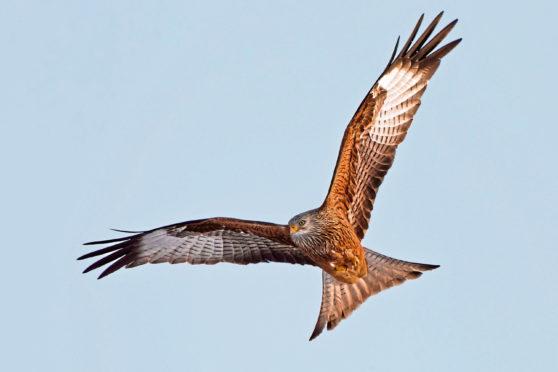Driving past Auchterarder on my way up to Crieff, and then onto my final destination in Glen Almond, Keith Broomfield spotted a large but slender-winged bird, with a distinctive fork-tail, soared high above the rolling countryside.
It was a red kite, a most magnificent raptor, which is becoming increasingly frequent in Courier Country. I only managed a glimpse, as I needed to concentrate on the road, but the profile was so distinctive that its identity immediately shone out at me.
Driving on, I reflected upon the sea-change in our countryside in recent decades, which has seen many new arrivals. As a youngster growing up in the 1970s, I used to avidly thumb-through my Collins Pocket Guide to British Birds, where the entry for the red kite read: “…breeding only in central Wales, where fewer than 20 pairs survive”.
Now, red kites are widely spread throughout Scotland, thanks to reintroduction schemes, and there are currently about 300 pairs spread from Dumfries and Galloway right up to more northern parts. The white-tailed eagle has made a similarly spectacular spread, now numbering around 100 breeding pairs.
Then, there are beavers, which are now relatively common in the Tay catchment and are spreading into the Forth. The difference with beavers is that they stem from accidental or unauthorised releases 20 or so years ago, rather than from controlled reintroductions. But that doesn’t matter, for beavers belong here and were formerly native before being hunted to extinction. They have as much belonging to our landscape as does a blackbird or chaffinch.
The recent revival of all these animals is down to a more enlightened attitude in these modern times. Previously, these creatures were needlessly and ruthlessly persecuted; now they have a free reign and can prosper. Give nature a chance, it will thrive, and if nature blossoms, then so does humankind.
By the time I reached Newton Bridge at the upper part of Glen Almond, a blizzard had taken grip and as I walked along the River Almond, the snow blew and swirled around me. The clouds then parted, and the sun temporarily shone down upon this spectacular landscape of hill and glen. A flash of movement on the far side of the glen and a red kite swooped along its flank before disappearing around a spur. Two kites in one day; that’s not bad, I thought to myself.
Soon, another tempestuous snow-storm blew-in from the top of the glen and all around me became a sea of tumbling opaqueness. I pressed-on, but it became too much, so I decided to beat a retreat.
On the final leg of my return journey, I drove the moor road from Comrie down to Braco. On glancing out the car, a familiar long-winged bird crested a hilltop. It was another kite; a glorious hat-trick, and the 1973 edition of the Collins Pocket Guide to British Birds had well and truly been consigned to history.










